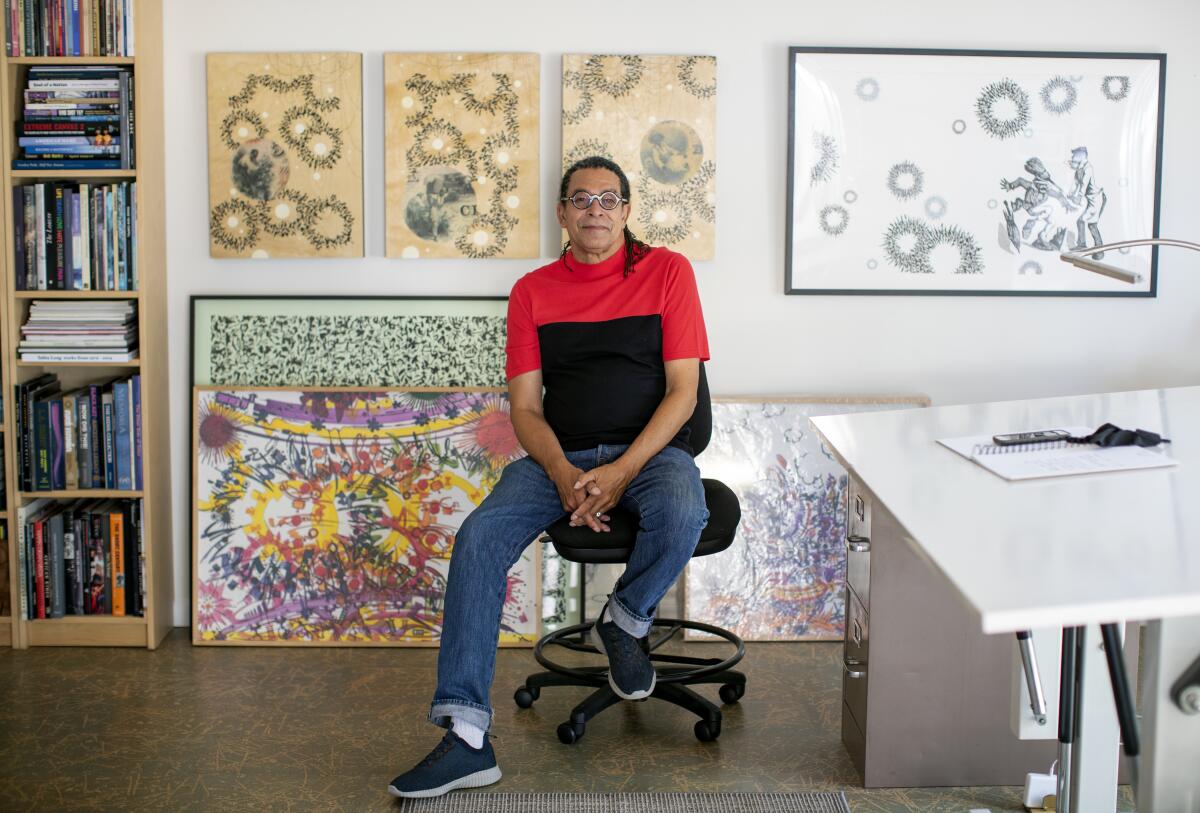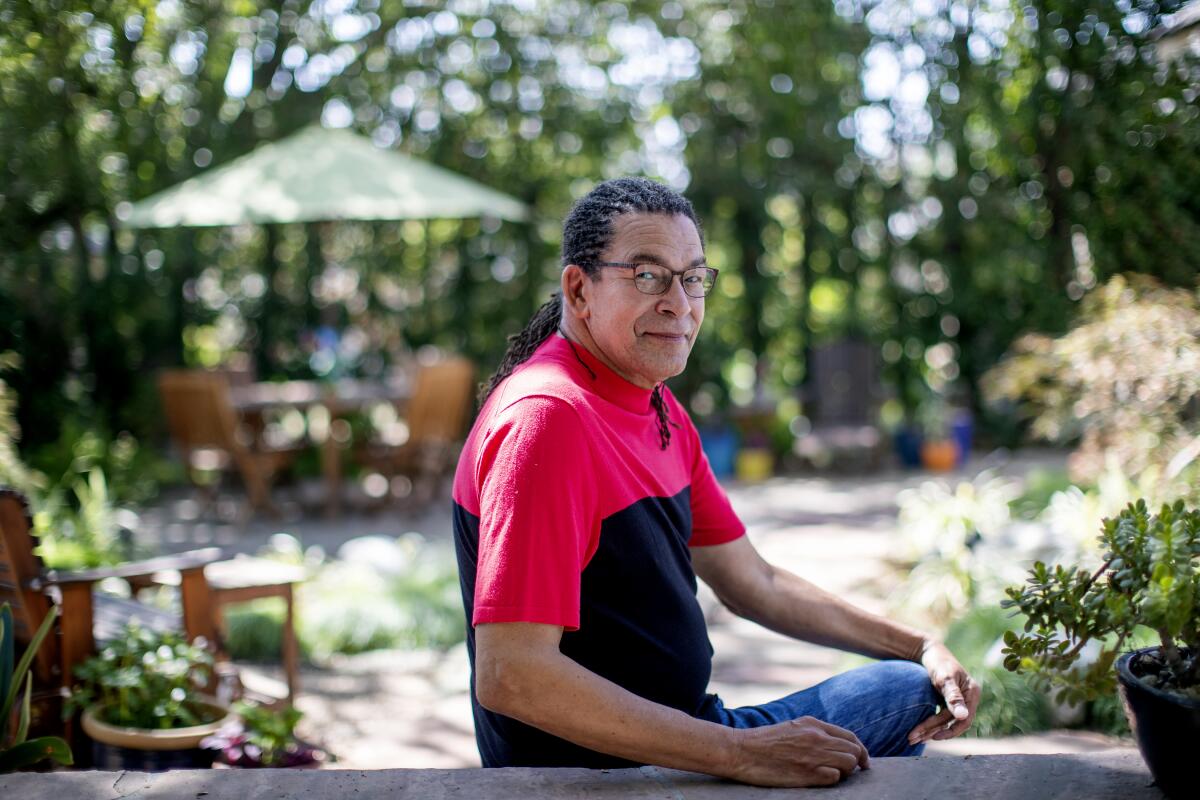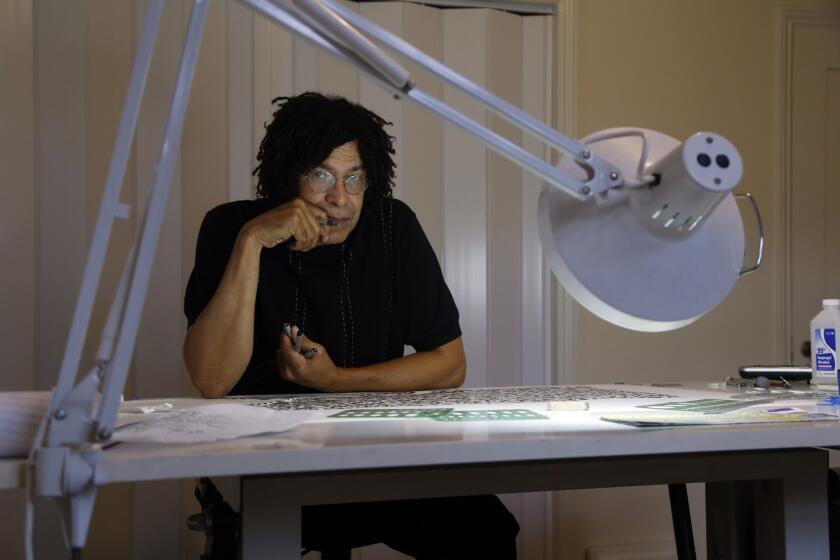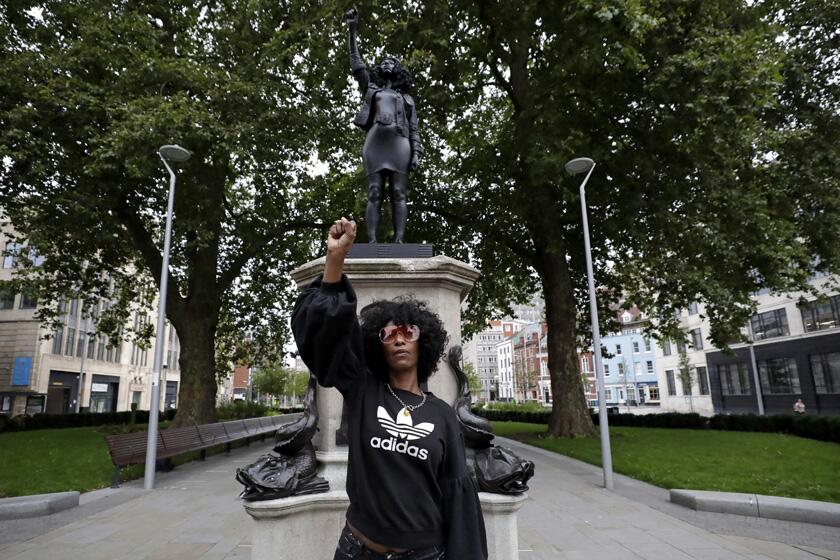How artist Mark Steven Greenfield’s Black Madonnas vanquish white supremacy

- Share via
Step into William Turner Gallery in Santa Monica and you may think you’ve been transported to an Italian Renaissance chapel. The white walls of the gallery glimmer with more than a dozen paintings of intimately scaled Madonnas framed in gold leaf. Each cradles a Christ child in maternal embrace. In the background, it is possible to make out fragments of landscape and other curious scenes.
And those scenes are indeed curious. They depict a Confederate monument being toppled, an antebellum plantation in flames, a pair of flying saucers blasting away at a neo-Nazi. And those Madonnas? They are all Black — graceful queens in fine robes and natural hair nurturing their infants as white supremacy is vanquished just over their shoulder.
The paintings, by Los Angeles artist Mark Steven Greenfield, are as masterful as they are pointed, toying with race as well as the tropes of Western art history. “Black Madonna,” as the show is titled, unites the artist’s interest in a number of themes: pattern-making meant to evoke meditative states, the Black figure in popular culture, as well as the work of Renaissance painters.
“The whole thing behind a lot of art now, it’s so conceptual, and there’s not much appreciation for craft,” Greenfield says, seated at a tidy drafting table in his home studio in Altadena. “I’ve always admired the old masters.
“I was taking those classical paintings by Bellini and Raphael and Da Vinci, and I was Black-ifying them,” says the artist, 69, who has long delved into the ways in which race and its signifiers materialize in culture. “When I was taking art history as an undergrad, we used to have to dissect these works, but this was liberating because I could just play with it.”
And the paintings do give a sense of an artist who is at play with the canon, even as he dwells on far more serious business.
William Turner, the gallery’s founder, says he was bowled over by the works 18 months ago, when he first caught sight of them during a random studio visit.
“They were beautiful, engaging, played on several levels of meaning and had something important to say,” he states via email. “They also spoke to themes Mark has dealt with his entire career — confronting us with images that shift our perspective just enough to shift everything.”
In a 2014 retrospective at the California African American Museum, Greenfield presented a series of works that engaged the history of blackface and minstrelsy in ways both literal and abstract. “My feeling was that it was time to take ownership of it and to take the power away from it,” he said at the time.
He has also been intrigued by the ways in which African spirituality has manifested in the Americas, such as the Yoruban egun, an ancestral representation from Africa that also appears in Brazilian rites. Contemporary interpretations of these figures appeared in a painting series the artist created in the 2010s titled “Egunguns & Anger Management.”
The Black Madonna series emerged almost by accident when another project failed to come to fruition.
A few years back, a gallery in Italy asked if Greenfield could design a Nativity for a Christmas-themed exhibition. The artist got to work doing sketches. “But I wasn’t feeling it,” he says.
In doing research, however, Greenfield had come across the Black Madonna, depictions of the Virgin Mary with dark skin that date back hundreds of years — at least to the Middle Ages, if not earlier.
“In Europe they have hundreds of them,” he says. “In France. There are some in Poland and Italy.”
Of all the uncomfortable episodes in American history, that of minstrelsy is one that many people would like to forget.
As an artist, he was immediately compelled by the Black Madonna because her origin story is so mysterious.
Black Madonnas may have emerged as syncretic symbols that linked pagan beliefs connected with fertility and the Mother Earth to Christianity. They may have come out of Byzantine artistic traditions. Or they could have been the product of a lot of candle smoke inside of medieval churches, which may have turned the statues black with soot. (In one recent, infamous case, controversial restoration work at the Chartres Cathedral in France transformed a Black Madonna into a white one to the dismay of the devout.)
What is certain is that Black Madonnas exist — and at least some of those representations were intentional. As artist and scholar Justin Randolph Thomas notes in an essay for an upcoming catalog of Greenfield’s work, the Black Madonna of Tindari, in Sicily, is inscribed with the Latin “Nigra Sum Sed Formosa.” The phrase translates to “I Am Black but Beautiful,” a passage from the Song of Solomon in the Old Testament. (Cellist Pablo Casals wrote a stirring choral motet inspired by it in 1942.)
“The fact that it was such a mystery means that it was really open to interpretation,” Greenfield says.
That left him free to imbue the icon with the stories of our age.
Those stories draw from contemporary culture in ways that are at once acerbic and poignant. In one panel, the Christ child clutches a hair pick as he feeds from Mary’s breast. In another, the young savior plays with a cannabis leaf. A larger triptych features a Black Madonna in the pose of Michelangelo’s “Pietà,” a mother lamenting the body of her son, a pile of designer sneakers at her feet.
Shouldn’t public monuments have public input? In the George Floyd moment, artists and designers are changing the nature of monuments and the histories they honor.
In the background of many canvases lurks colonialism’s legacy of white supremacy. A cotton field, that crop known for its dependence on the labor of the enslaved, appears as backdrop in one painting. In another, a finely rendered gas chamber, symbol of the carceral state, seems ready to claim the Christ child as its own. In many of these scenes, white supremacists get their cartoonish comeuppances: abducted by aliens, blown up with dynamite, burned at the stake.
As the series progressed, Greenfield says with a chuckle, “I was running out of ways to kill white supremacists.”
The Black Madonna series has marked an intensive creative burst for the artist. “It’s the first time I’ve painted like that in 30 years,” Greenfield says.
But the series is in keeping with the ways he has explored the nature of race in images throughout his life.
Greenfield was born in Los Angeles but raised all over the country and the world — including Taiwan and Germany — thanks to his father’s job with the Air Force as a Tuskegee Airman. Upon their return to Los Angeles, the family lived first in Leimert Park, then in Windsor Hills.
Always a doodler, Greenfield found a saving grace in art. “I was running around with some hardcore people,” he recalls. A teacher at Los Angeles High School pulled him aside and told him: “You could be a pretty good artist if you live that long.”
He honed his skills through a special program funded by the Golden State Mutual Life Insurance Co. that allowed him to take drawing classes as a high schooler at the Otis Art Institute (now the Otis College of Art and Design). That put him in the orbit of important 20th century Black artists such as John Riddle, Charles White and Bill Pajaud — key sources of inspiration.
“I sold my first piece at 16 at the Watts Summer Festival for a whopping $35,” Greenfield recalls. “It was Conté crayon on burlap, and it was very much in the style of Charles White,” known for figurative work.

Undergraduate studies at Cal State Long Beach proved to be formative — though for all the wrong reasons.
“I thought the arts were free of racism,” Greenfield says. “I thought it was more liberal. And I got there and I realized, no, it is not. When I showed up at the first painting class, the teacher said, ‘We don’t have enough room for you in this class, but the class across the way is empty, so you can sit there.’”
Over the semester, he worked by himself in that room, with the teacher materializing occasionally for instruction. The year was 1969.
That experience and others, along with the activism of the times, fed the underlying purpose of his work.
“Coming out of the nationalist movement and the Black Power movement, one of the things that we started to understand was that the art that we did was an important part of that narrative,” he says. “On one level, you have academia telling you should be doing art for yourself — and that whole idea of self-indulgence gets carried a bit too far in some instances. But we were looking at art as being about something you have to say.”
The insistence on saying something hasn’t always made him popular with the art market. After college, Greenfield says that art galleries were often a dead end. He would show his slides, only to receive a patronizing response: “We like your work, but your work, it’s really ethnic.”
Charles White was a spectacular draftsman.
To support his painting, Greenfield worked a range of jobs — principally in the arts. For a time, he was a graphic designer for the Los Angeles Police Academy. (“All the certificates for all the graduates? I did the calligraphy for them.”) He was also director of the Watts Towers Arts Center and the Los Angeles Municipal Art Gallery. And he is a longtime art teacher at Cal State Los Angeles, where he received a master of fine arts in painting and drawing in 1987.
Maintaining financial independence has allowed him to pursue his art unfiltered. “I tell my students this is a passion,” he says. “If you follow it, find something to support that passion. Otherwise, you will find yourself making commodities.”
The work at William Turner captures his range of passions — articulating America’s fraught relationship with race, but also rendering moments of triumphant Black power, such as a portrait of Haitian liberator Toussaint Louverture.
Also materializing in the works are glyphs inspired by meditation. (Greenfield has practiced meditation for 48 years. He was introduced to it by college friends, who he says told him, “Acid is fun, but you should try this.”)
The glyphs emerge intuitively. He neither sketches them out in advance, nor does he have a set system for producing them. Each of the Black Madonna paintings features a sequence of circular discs. All of these are embedded with glyphs, except for the one that features the Madonna.
“When you see these discs, that corresponds to the characterization of the mantra,” he says. “In the course of meditation, you have a thought come into your head, you entertain that thought and then you let that thought go.”
The Madonnas — along with the violent scenes behind them — mark the riotous visions that he entertains and then releases. But other works in the show evoke influences that are more lasting.
A side gallery at William Turner features several paintings composed entirely of glyphs, including a mournful piece inspired by the tragedy of the slave ship Zong. The ship became synonymous with the worst abuses of the slave trade in the late 18th century when its captain tossed its enslaved passengers into the Atlantic, then turned around and tried to claim their value with the insurance company. (The event helped fuel the abolitionist movement.)
“There are so many bones at the bottom of the sea, and those bones relate to somebody,” Greenfield says of the Middle Passage. “The Atlantic Ocean is the largest graveyard around, and there is no commemoration of that.”
The artist commemorates them in his own way, with a 2019 painting titled “Zong,” plunging the bodies of the ship’s passengers into an ocean of his meditative markings. Those people are gone. But they remain forever on Greenfield’s mind.
Mark Steven Greenfield — "Black Madonna"
Where: William Turner Gallery, Bergamot Station, 2525 Michigan Ave. No. E1, Santa Monica
When: Through Nov. 28
Info: Due to COVID-19 protocols, visits are by appointment and can be scheduled through the gallery’s website, williamturnergallery.com
More to Read
The biggest entertainment stories
Get our big stories about Hollywood, film, television, music, arts, culture and more right in your inbox as soon as they publish.
You may occasionally receive promotional content from the Los Angeles Times.













